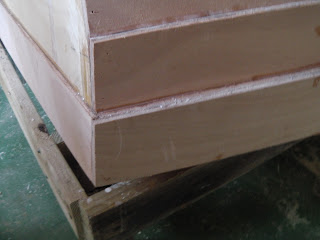It's been two weeks since the last post and there isn't much obvious progress. However, I did go sailing for a week in my John Welsford Navigator and had a great time. I have also bevelled the transom, keelson and stem in readiness for the planks to go on - no pics of this as the changes are not obvious and photos of a big pile of wood shavings are not interesting. I bought the plywood for the planks, 9 sheets of marine grade 9mm Gaboon ply. Also 5 sheets of 4mm construction grade ply to make patterns for the planks. Interestingly, the 5 sheets of construction grade ply cost less than a single sheet of the 9mm marine ply!
The planks are over 5 metres long so I had to scarph joint the 2.4 metre sheets to get the necessary length. Here are some photos of the process. First, 4 sheets are arranged across the end of the bench in a staircase formation with each "tread" being 72mm wide. This provides an overlap in the joint of 8 times the thickness of the ply.
The steps are now planed away to create a continuous slope. As this progresses the glue lines in the ply give a good indication of how even the slope is. The planes need to be sharp and resharpened during the job but it is still hard work!
The sloping surfaces are painted with unthickened epoxy and left for 15 minutes or so to allow the epoxy to soak into the end grain of the ply. Thickened epoxy is applied to 2 of the 4 slopes and the joints positioned carefully so that the ply surfaces are level and the long edge is straight. I tack each pair of sheets together with a couple of staples to stop them slipping apart and then clamp the joints with 2 heavy cauls. One of the cauls is straight, the other has a slight crown on it (about 3mm higher in the middle) to counteract the tendency for the cauls to bend when clamped at the ends.
With one joint made the sheets are now almost 4.8 metres long and the scraphing process was repeated to add another 450mm to one end. The sheets are now 5.25 metres long and are filling the space in my shed quite effectively!.
While the scarph joints were setting I made a pattern for the first (garboard) plank using the cheap 4mm ply. This is pretty straightforward. I butt join the sheets of ply to get the length and then cut off a strip wider than the plank. This strip is then laid over the building frame and held in place with a few temporary nails. The edges of the plank are marked on the pattern strip from the moulds. The pattern is taken off and the marks are joined up using a long batten to get a fair curve through the points. Cut and trimmed to the line with a handplane the pattern is returned to the moulds and checked for fit.
Once the pattern is correct it is laid over 2 sheets of the marine ply a a line drawn around it. The planks are then cut with a jigsaw and cleaned up with a handplane. Here is the pair of finished planks.
The planks are laid on the moulds and held with clamps. Inevitably, some fine tuning is required but this can be done with a hand plane. Here are the planks at the bow of the boat. There is considerable twist required to get them into place and I'm doing this with shaped blocks and, while the glue dries, a few temporary screws will be used.
At the stern the planks will be easier to fix but some fine tuning is requireed here as well. The stripes on the edge of the transom are pieces of ply that I had to add to correct an error made while bevelling the transom. The bevel was perfect but I forgot to allow for the fact that the planks overlap and need the transom to be stepped to accomodate the overlap.
Last comment at this stage; this is my second glued lapstrake or clinker ply boat and the first pair of planks are the most difficult to fit. The process for the remaining planks is the same but they don't but together along the centreline of the boat and there isn't as much twist to deal with at the bow.



















































